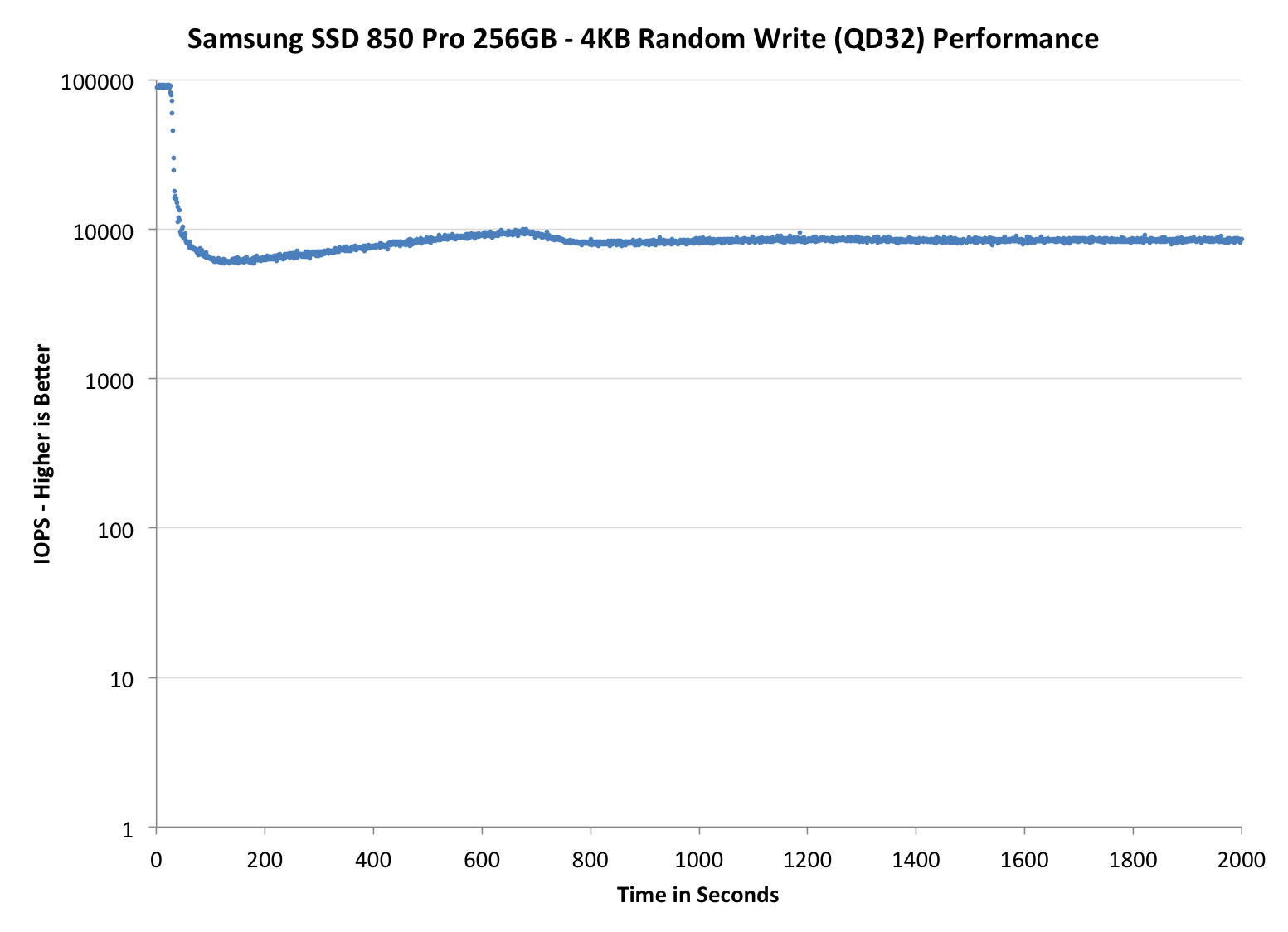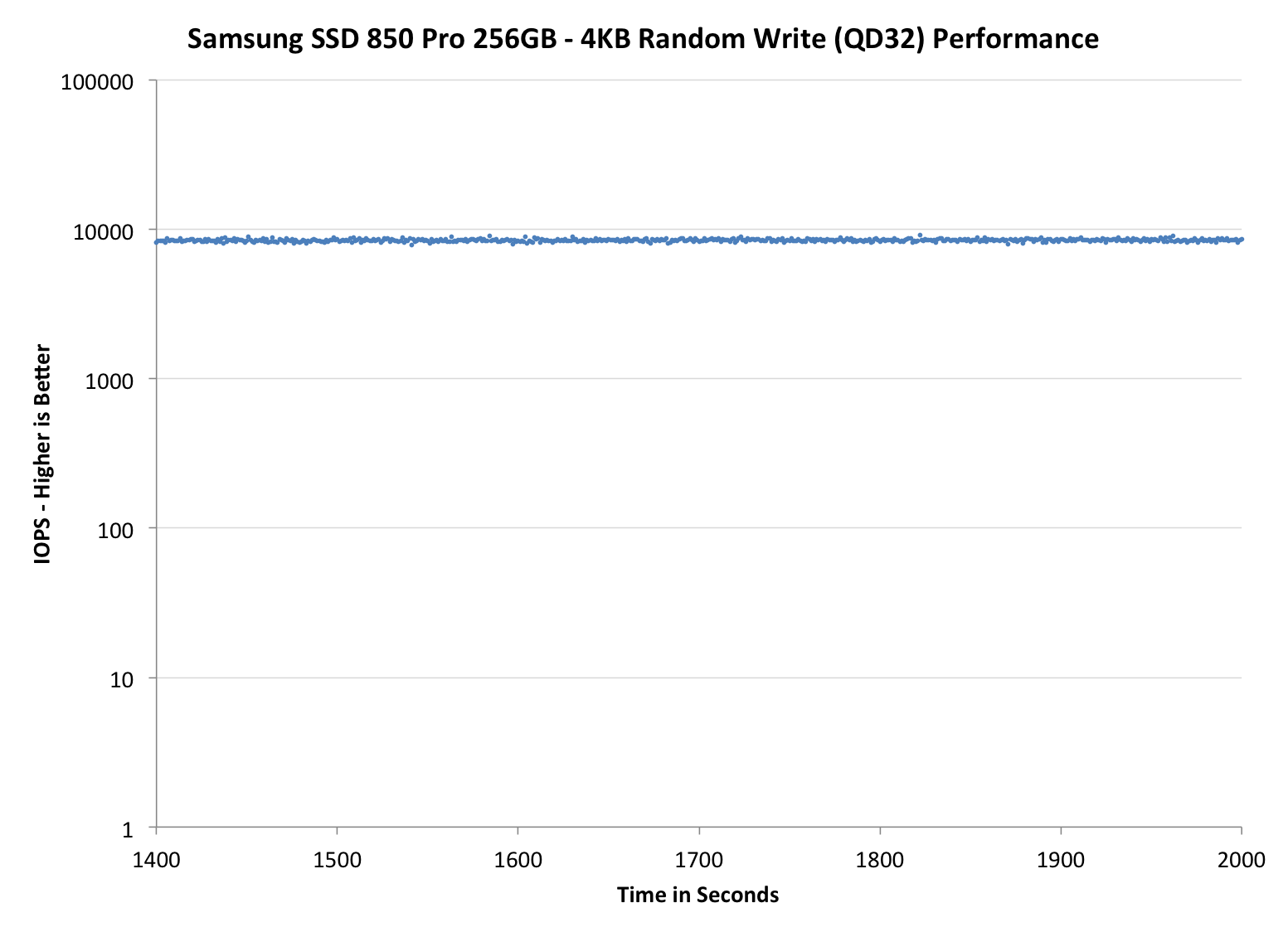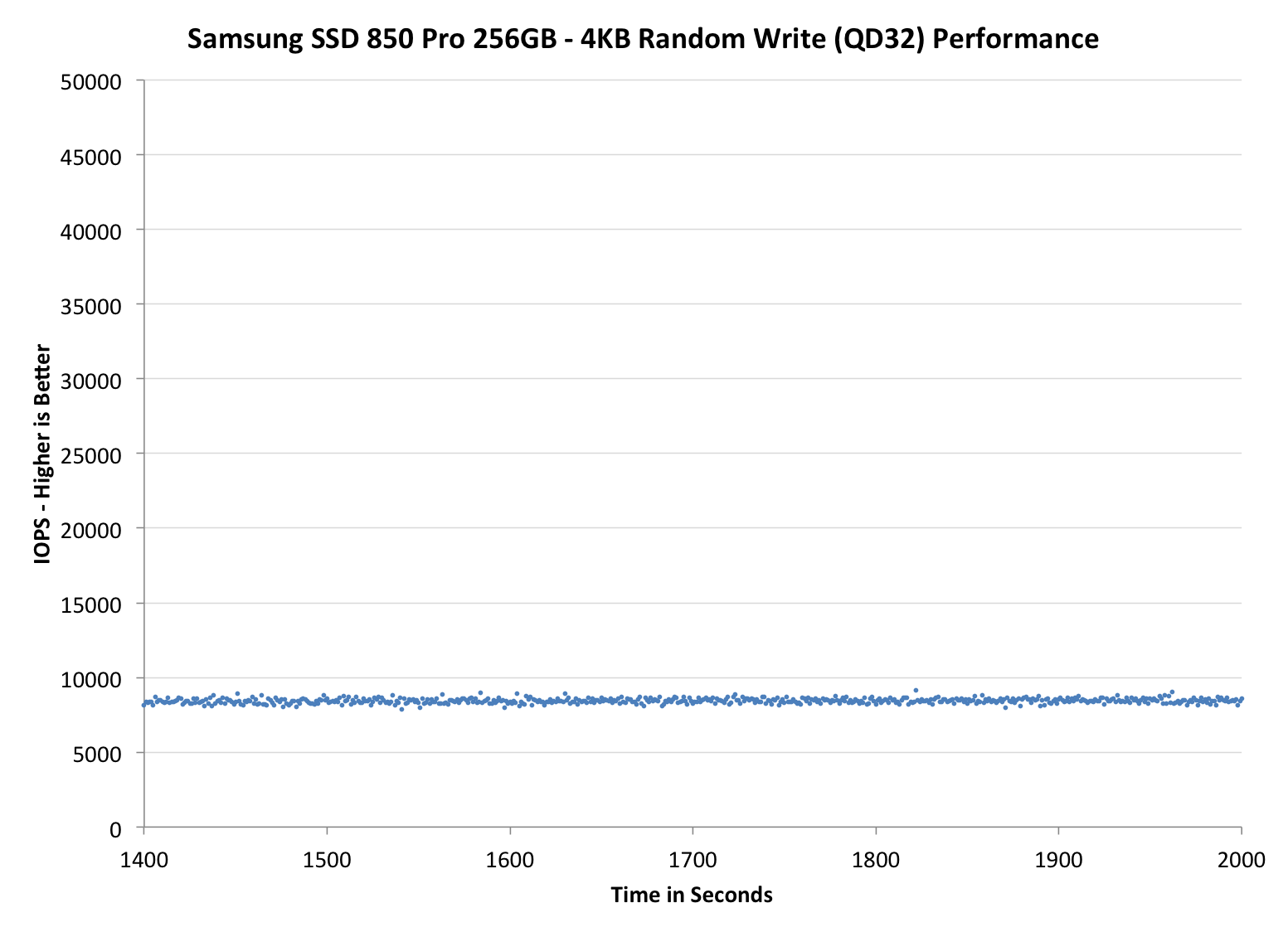Samsung SSD 850 Pro (128GB, 256GB & 1TB) Review: Enter the 3D Era
by Kristian Vättö on July 1, 2014 10:00 AM ESTPerformance Consistency
Performance consistency tells us a lot about the architecture of these SSDs and how they handle internal defragmentation. The reason we don’t have consistent IO latency with SSD is because inevitably all controllers have to do some amount of defragmentation or garbage collection in order to continue operating at high speeds. When and how an SSD decides to run its defrag or cleanup routines directly impacts the user experience as inconsistent performance results in application slowdowns.
To test IO consistency, we fill a secure erased SSD with sequential data to ensure that all user accessible LBAs have data associated with them. Next we kick off a 4KB random write workload across all LBAs at a queue depth of 32 using incompressible data. The test is run for just over half an hour and we record instantaneous IOPS every second.
We are also testing drives with added over-provisioning by limiting the LBA range. This gives us a look into the drive’s behavior with varying levels of empty space, which is frankly a more realistic approach for client workloads.
Each of the three graphs has its own purpose. The first one is of the whole duration of the test in log scale. The second and third one zoom into the beginning of steady-state operation (t=1400s) but on different scales: the second one uses log scale for easy comparison whereas the third one uses linear scale for better visualization of differences between drives. Click the buttons below each graph to switch the source data.
For more detailed description of the test and why performance consistency matters, read our original Intel SSD DC S3700 article.
 |
|||||||||
| Samsung SSD 850 Pro | Samsung SSD 840 Pro | SanDisk Extreme Pro | Intel SSD 730 | OCZ Vector 150 | |||||
| 7% Over-Provisioning | - | - | - | ||||||
| 12% Over-Provisioning | |||||||||
| 25% Over-Provisioning | |||||||||
Wow, this is awesome. Even with the default 7% over-provisioning, the 850 Pro is pushing almost as many IOPS as the Extreme Pro with its 12% over-provisioning. When the over-provisioning is increased to the same 12% level, the 850 Pro is a leader without a doubt. Only the Vector 150 can come close, although it is nowhere hear as constant as the IOPS is ranging between 10K and 30K, whereas the 850 Pro can maintain a steady line.
When compared with the 840 Pro, the upgrade is tremendous. IO consistency was always the weak point of the 840 Pro, so it is great to see that Samsung has paid a great effort to fix that in the 850 Pro. A part of the performance increase obviously comes from the usage of V-NAND because with shorter program and erase latencies, the steady-state performance increases as the garbage collection takes less time and there are more empty blocks available.
Some of you may wonder the odd capacities at 25% over-provisioning but the reason is that I noticed an error in the old ones. Basically, the old 25% numbers were in gibibytes (i.e. 1024^3 bytes) whereas the other capacities have always been in gigabytes (1000^3 bytes). I decided to unify the capacities and now they are all reported in gigabytes. The actual testing or over-provisioning levels have not changes -- it is simply a matter of how the capacities are represented.
 |
|||||||||
| Samsung SSD 850 Pro | Samsung SSD 840 Pro | SanDisk Extreme Pro | Intel SSD 730 | OCZ Vector 150 | |||||
| 7% Over-Provisioning | - | - | - | ||||||
| 12% Over-Provisioning | |||||||||
| 25% Over-Provisioning | |||||||||
 |
|||||||||
| Samsung SSD 850 Pro | Samsung SSD 840 Pro | SanDisk Extreme Pro | Intel SSD 730 | OCZ Vector 150 | |||||
| 7% Over-Provisioning | - | - | - | ||||||
| 12% Over-Provisioning | |||||||||
| 25% Over-Provisioning | |||||||||










160 Comments
View All Comments
MrSpadge - Tuesday, July 1, 2014 - link
No, it's really "600 MB/s whatever". In reality about 550 MB/s seems to be the maximum. With 300r + 300w full duplex neither read nor write could surpass 300 MB/s.zmeul - Tuesday, July 1, 2014 - link
why I ask thisI see a lot op people putting SSDs in RAID0, and I wonder why ... to me, it seems totally pointless
the system doesn't do only writes or only reads, so what's the point? well, except in the cases where you copy/move some huge files from one matrix to another
Cerb - Tuesday, July 1, 2014 - link
Copying large files, and loading large files. Realistically, you can copy from a new SSD to another at anywhere from 250MBps to 450MBps (including OS/filesystem overhead). That's halved, or worse, copying from an SSD to itself. RAID 0 gives you an approximately linear bandwidth increase. If you don't need a logical or physical separation of data locations, RAID 0 beats a separate drive.When I'm backing up my Bethesda games directory, I wish I had more speed, as it could be done faster in a RAID. However, I only do that one or two times per month (all my saves for all my games are on automatic backup).
For typical light random IO, it very much is pointless.
457R4LDR34DKN07 - Wednesday, July 2, 2014 - link
Easy, say you have 2 sata 2.0 SSD but want sata 3.0 speeds.Kevin G - Tuesday, July 1, 2014 - link
Typo?"I bet many of you would have liked to see the 850 Pro move to the PCIe interface but I understand Samsung's decision to hold on with PCIe for a little while longer."
I think the second PCIe should be SATA.
stickmansam - Tuesday, July 1, 2014 - link
of the "on" could be a "off'Solid State Brain - Tuesday, July 1, 2014 - link
How many P/E cycles does the NAND on this drive support, by SMART data?Kristian Vättö - Tuesday, July 1, 2014 - link
I will test that as soon as I get back from Korea, as well as send you the Extreme Pro data. Sorry for not replying to your email earlier, I kind of lost focus on everything else when I started working on this review :)Solid State Brain - Tuesday, July 1, 2014 - link
No problem, thanks!extide - Tuesday, July 1, 2014 - link
You should actually put up a little pipeline article with all of this data, because it would be interesting to me, and I am sure lots of other users as well.